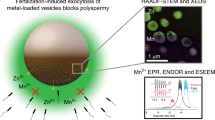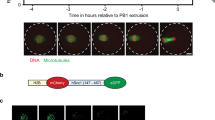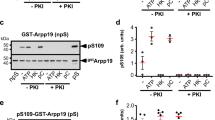Abstract
Fertilization induces a transient increase in cytoplasmic Ca2+ concentration in animal eggs that releases them from cell cycle arrest in the second meiotic metaphase1. In frog eggs, Ca2+ activates Ca2+/calmodulin-activated kinase, which inactivates cytostatic factor2,3,4,5, allowing the anaphase-promoting factor to turn on and ubiquitinate cyclins and securin, which returns the cell cycle to interphase6. Here we show that the calcium-activated protein phosphatase calcineurin7 is also important in this process. Calcineurin is transiently activated after adding Ca2+ to egg extracts, and inhibitors of calcineurin such as cyclosporin A (ref. 8) delay the destruction of cyclins, the global dephosphorylation of M-phase-specific phosphoproteins and the re-formation of a fully functional nuclear envelope. We found that a second wave of phosphatase activity directed at mitotic phosphoproteins appears after the spike of calcineurin activity. This activity disappeared the next time the extract entered M phase and reappeared at the end of mitosis. We surmise that inhibition of this second phosphatase activity is important in allowing cells to enter mitosis, and, conversely, that its activation is required for a timely return to interphase. Calcineurin is required to break the deep cell cycle arrest imposed by the Mos-MAP (mitogen-activated protein) kinase pathway4,5,9, and we show that Fizzy/Cdc20, a key regulator of the anaphase-promoting factor6, is an excellent substrate for this phosphatase.
This is a preview of subscription content, access via your institution
Access options
Subscribe to this journal
Receive 51 print issues and online access
$199.00 per year
only $3.90 per issue
Buy this article
- Purchase on Springer Link
- Instant access to full article PDF
Prices may be subject to local taxes which are calculated during checkout




Similar content being viewed by others
References
Busa, W. B. & Nuccitelli, R. An elevated free cytosolic Ca2+ wave follows fertilization in eggs of the frog, Xenopus laevis. J. Cell Biol. 100, 1325–1329 (1985)
Lorca, T. et al. Calmodulin-dependent protein kinase II mediates inactivation of MPF and CSF upon fertilization of Xenopus eggs. Nature 366, 270–273 (1993)
Rauh, N. R., Schmidt, A., Bormann, J., Nigg, E. A. & Mayer, T. U. Calcium triggers exit from meiosis II by targeting the APC/C inhibitor XErp1 for degradation. Nature 437, 1048–1052 (2005)
Schmidt, A., Rauh, N. R., Nigg, E. A. & Mayer, T. U. Cytostatic factor: an activity that puts the cell cycle on hold. J. Cell Sci. 119, 1213–1218 (2006)
Liu, J., Grimison, B. & Maller, J. L. New insight into metaphase arrest by cytostatic factor: from establishment to release. Oncogene 26, 1286–1289 (2007)
Peters, J. M. The anaphase promoting complex/cyclosome: a machine designed to destroy. Nature Rev. Mol. Cell Biol. 7, 644–656 (2006)
Stewart, A. A., Ingebritsen, T. S., Manalan, A., Klee, C. B. & Cohen, P. Discovery of a Ca2+- and calmodulin-dependent protein phosphatase: probable identity with calcineurin (CaM-BP80). FEBS Lett. 137, 80–84 (1982)
Liu, J. et al. Calcineurin is a common target of cyclophilin-cyclosporin A and FKBP-FK506 complexes. Cell 66, 807–815 (1991)
Sagata, N., Watanabe, N., Vande Woude, G. F. & Ikawa, Y. The c-mos proto-oncogene product is a cytostatic factor responsible for meiotic arrest in vertebrate eggs. Nature 342, 512–518 (1989)
Murray, A. W., Solomon, M. J. & Kirschner, M. W. The role of cyclin synthesis and degradation in the control of maturation promoting factor activity. Nature 339, 280–286 (1989)
Liu, J. & Maller, J. L. Calcium elevation at fertilization coordinates phosphorylation of XErp1/Emi2 by Plx1 and CaMK II to release metaphase arrest by cytostatic factor. Curr. Biol. 15, 1458–1468 (2005)
Peters, J. M., King, R. W., Hoog, C. & Kirschner, M. W. Identification of BIME as a subunit of the anaphase-promoting complex. Science 274, 1199–1201 (1996)
Schmidt, A. et al. Xenopus polo-like kinase Plx1 regulates XErp1, a novel inhibitor of APC/C activity. Genes Dev. 19, 502–513 (2005)
Klee, C. B., Ren, H. & Wang, X. Regulation of the calmodulin-stimulated protein phosphatase, calcineurin. J. Biol. Chem. 273, 13367–13370 (1998)
Chung, E. & Chen, R. H. Phosphorylation of Cdc20 is required for its inhibition by the spindle checkpoint. Nature Cell Biol. 5, 748–753 (2003)
Lorca, T. et al. An okadaic acid-sensitive phosphatase negatively controls the cyclin degradation pathway in amphibian eggs. Mol. Cell. Biol. 11, 1171–1175 (1991)
Stewart, A. A., Ingebritsen, T. S. & Cohen, P. The protein phosphatases involved in cellular regulation. 5. Purification and properties of a Ca2+/calmodulin-dependent protein phosphatase (2B) from rabbit skeletal muscle. Eur. J. Biochem. 132, 289–295 (1983)
Westendorf, J. M., Rao, P. N. & Gerace, L. Cloning of cDNAs for M-phase phosphoproteins recognized by the MPM2 monoclonal antibody and determination of the phosphorylated epitope. Proc. Natl Acad. Sci. USA 91, 714–718 (1994)
Blow, J. J. & Laskey, R. A. A role for the nuclear envelope in controlling DNA replication within the cell cycle. Nature 332, 546–548 (1988)
Chatterjee, S., Javier, M. & Stochaj, U. In vivo analysis of nuclear protein traffic in mammalian cells. Exp. Cell Res. 236, 346–350 (1997)
Meijer, L. et al. Biochemical and cellular effects of roscovitine, a potent and selective inhibitor of the cyclin-dependent kinases cdc2, cdk2 and cdk5. Eur. J. Biochem. 243, 527–536 (1997)
Crabtree, G. R. Calcium, calcineurin, and the control of transcription. J. Biol. Chem. 276, 2313–2316 (2001)
Nebreda, A. R. & Hunt, T. The c-mos proto-oncogene protein kinase turns on and maintains the activity of MAP kinase, but not MPF, in cell-free extracts of Xenopus oocytes and eggs. EMBO J. 12, 1979–1986 (1993)
Haccard, O. et al. Induction of metaphase arrest in cleaving Xenopus embryos by MAP kinase. Science 262, 1262–1265 (1993)
Maller, J. L. et al. The pathway of MAP kinase mediation of CSF arrest in Xenopus oocytes. Biol. Cell 93, 27–33 (2001)
Yudkovsky, Y., Shteinberg, M., Listovsky, T., Brandeis, M. & Hershko, A. Phosphorylation of Cdc20/fizzy negatively regulates the mammalian cyclosome/APC in the mitotic checkpoint. Biochem. Biophys. Res. Commun. 271, 299–304 (2000)
Inoue, D., Ohe, M., Kanemori, Y., Nobui, T. & Sagata, N. A direct link of the Mos–MAPK pathway to Erp1/Emi2 in meiotic arrest of Xenopus laevis eggs. Nature 446, 1100–1104 (2007)
Nishiyama, T., Ohsumi, K. & Kishimoto, T. Phosphorylation of Erp1 by p90rsk is required for cytostatic factor arrest in Xenopus laevis eggs. Nature 446, 1096–1099 (2007)
Pomerening, J. R., Kim, S. Y. & Ferrell, J. E. Systems-level dissection of the cell-cycle oscillator: bypassing positive feedback produces damped oscillations. Cell 122, 565–578 (2005)
Yamano, H., Gannon, J., Mahbubani, H. & Hunt, T. Cell cycle-regulated recognition of the destruction box of cyclin B by the APC/C in Xenopus egg extracts. Mol. Cell 13, 137–147 (2004)
Murray, A. W., Solomon, M. J. & Kirschner, M. W. The role of cyclin synthesis and degradation in the control of maturation promoting factor activity. Nature 339, 280–286 (1989)
Blow, J. J. & Laskey, R. A. A role for the nuclear envelope in controlling DNA replication within the cell cycle. Nature 332, 546–548 (1988)
Mackintosh, C. & Moorhead, G. in Protein phosphorylation: A practical approach (ed. Hardie, D. G.) 153–181 (Oxford University Press, Oxford, 1999)
Mertz, P., Yu, L., Sikkink, R. & Rusnak, F. Kinetic and spectroscopic analyses of mutants of a conserved histidine in the metallophosphatases calcineurin and l protein phosphatase. J. Biol. Chem. 272, 21296–21302 (1997)
Acknowledgements
We thank H. Yamano and M. Dasso for gifts of the Xenopus Erp1 and GFP–NLS clones, respectively; C. Klee for advice about calcineurin biochemistry; T. Nishiyama and K. Ohsumi for anti-calcineurin A serum, anti-Erp1 antibody and sharing details of their parallel findings with us; S. Shenolikar for clones for inhibitor-1; H. Mahbubani and J. Kirk for care of frogs; and other members of the laboratory for advice and reagents. S.M. is supported by an EMBO long-term fellowship.
Author information
Authors and Affiliations
Corresponding author
Ethics declarations
Competing interests
Reprints and permissions information is available at www.nature.com/reprints. The authors declare no competing financial interests.
Supplementary information
Supplementary Figures
The file contains Supplementary Figures S1-S3 with Legends and additional methods. (PDF 315 kb)
Rights and permissions
About this article
Cite this article
Mochida, S., Hunt, T. Calcineurin is required to release Xenopus egg extracts from meiotic M phase. Nature 449, 336–340 (2007). https://doi.org/10.1038/nature06121
Received:
Accepted:
Issue Date:
DOI: https://doi.org/10.1038/nature06121
This article is cited by
-
YY1 activates EMI2 and promotes the progression of cholangiocarcinoma through the PI3K/Akt signaling axis
Cancer Cell International (2021)
-
A PP1–PP2A phosphatase relay controls mitotic progression
Nature (2015)
-
Modulation of cell cycle control during oocyte-to-embryo transitions
The EMBO Journal (2013)
-
Calcineurin Controls Voltage-Dependent-Inactivation (VDI) of the Normal and Timothy Cardiac Channels
Scientific Reports (2012)
-
Protein phosphatases and their regulation in the control of mitosis
EMBO reports (2012)
Comments
By submitting a comment you agree to abide by our Terms and Community Guidelines. If you find something abusive or that does not comply with our terms or guidelines please flag it as inappropriate.



